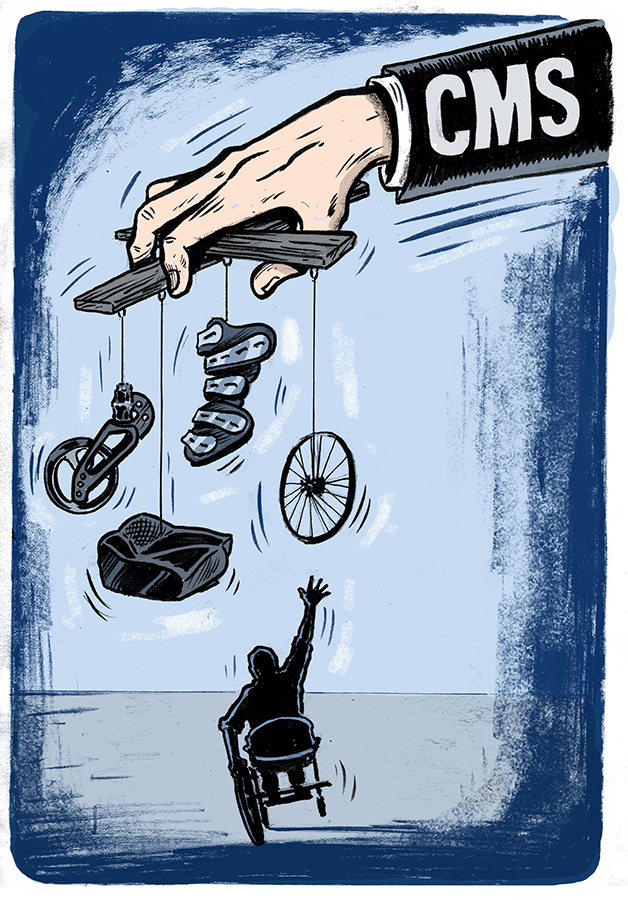On December 20, President Trump signed into law H.R. 1865, which funds the federal government through the end of September 2020. Tucked into the legislation was language that will have a much longer-lasting impact for a large number of wheelchair users. It exempts complex manual wheelchairs permanently from Medicare’s competitive bidding program, replacing temporary exemptions that were set to expire this year. It’s a policy advocates have been fighting years to secure.
Without digging too far into the weeds, the exemption will keep the highly specific, custom fitted manual wheelchairs that people with permanent disabilities need from being lumped together with lower quality ones. Power wheelchairs and components received a permanent exemption from the competitive bidding process in 2017, but the temporary exemption for manual chairs was set to expire this year.
Even with the exemptions in place, there is still a huge range of wheelchair styles that are listed under the same reimbursement rates. For example, the Medicare code for an Invacare MyOn folding wheelchair, which weighs 29.65 pounds and retails for $1,799, is the same one used for a TiLite TR titanium wheelchair, which weighs 9.3 pounds and retails for $4,595.
“When you have a chair that has a lot more engineering into it, higher quality components, higher quality materials, and it’s lumped into a reimbursement code that’s the same as a chair with off-the-shelf components and much lower quality components … what happens is the higher-end equipment ends up being something that a dealer can’t make a living providing,” says Dave Knight, territory sales manager for Permobil. If Medicare had put manual wheelchairs into the CBP, it would have further reduced the reimbursement rates for these chairs, making an already bad situation worse.
Furthermore, the bill has language that makes the Centers for Medicare and Medicaid Services reimburse manual wheelchair accessories at their regular rates instead of the lower competitive bid rates that they had been using. Congress had already exempted power wheelchairs and accessories from competitive bidding, but had failed to include manual chair accessories, so suppliers were being paid different rates for the same accessory, depending on what type of chair it went on.
And anyone who pushes a wheel, sits on a cushion and leans against a backrest all day, everyday knows how misleading a term like “accessories” is for these vital pieces of equipment. You also know that a ROHO isn’t a 2-inch foam cushion, and a wire-spoked wheel with metal pushrims might as well be square if you have limited arm strength and no grip. Given how different every wheelchair user’s body, functional abilities and daily lives are, there is no single cushion, wheel or backrest that works for all of us.
But under the CBP, suppliers were being paid a set, artificially low rate for these specialized pieces of equipment. Depending on the specific product and how it was coded — say a cushion for someone with a high-risk of skin breakdown who is also active and moves around a lot — a DME supplier might only be reimbursed pennies on the dollar. Either they provide the product the user needs, at a loss, or they steer the user toward a “similar” but suboptimal product on which they can stay in the black. It was a lose/lose/lose. Suppliers face ever shrinking profit margins; manufacturers get squeezed because of declining sales; wheelchairs users can’t get the equipment they need to stay heathy and independent.
With the new legislation, Medicare will have to reimburse for manual wheelchair accessories at the same, higher rate as for power chairs, hopefully improving manual wheelchair users’ access to specialized equipment that meets their needs. Organizations like United Spinal Association, the National Coalition for Assistive and Rehab Technology and dozens of others have spent years fighting for this change. This was an important step, but there’s a lot of fighting left to do.
Moving Forward
Don Clayback is the executive director of NCART, an advocacy organization that represents CRT suppliers and manufacturers. He says the major priority moving forward is legislation to require Medicare to carve out a separate benefit category for CRT so that reimbursement can better reflect the actual costs of equipment.
There is already precedent — custom orthotics and prosthetics have their own benefit category. The goal of moving CRT into its own category “is better safeguards, better coverage and more appropriate payment rates for both current technology and new technology,” says Clayback.
At NEW MOBILITY, we receive more comments from readers about the skyrocketing costs of adaptive equipment than possibly any other subject. As wheelchair users ourselves, we feel your pain. But these days, things aren’t easy for manufacturers or suppliers either. Materials, regulatory approval, R&D — everything is more expensive than it used to be. The pressures brought by increasingly stingy reimbursement rates for Medicare and private insurance alike are making an already shaky business environment even shakier, leading to further consolidation in the industry. When margins are tight, only the big survive, further reducing wheelchair users’ already limited access to essential equipment.
Getting new legislation passed isn’t easy — battling legislative inertia takes years of constant, coordinated advocacy. But the considerable effort spent advocating for CRT exemptions has already educated congressional offices on the value and the necessity of making sure wheelchair users have access to adaptive technology that works for them.
The recent legislation “solves a big problem for people who use complex manual wheelchairs,” says Clayback. “But it was also a big win because we’ve proven that Congress will respond to us. We’ve proven that Congress understands the difference in CRT. And I think we’ve proven that if people are willing to send emails and make some phone calls, and in some cases, come to Washington, it’ll pay off.”
For information about how to get involved, visit: unitedspinal.org/separate-medicare-crt.
** This post was originally published on https://www.newmobility.com/2020/02/complex-rehab-technology-battle/


